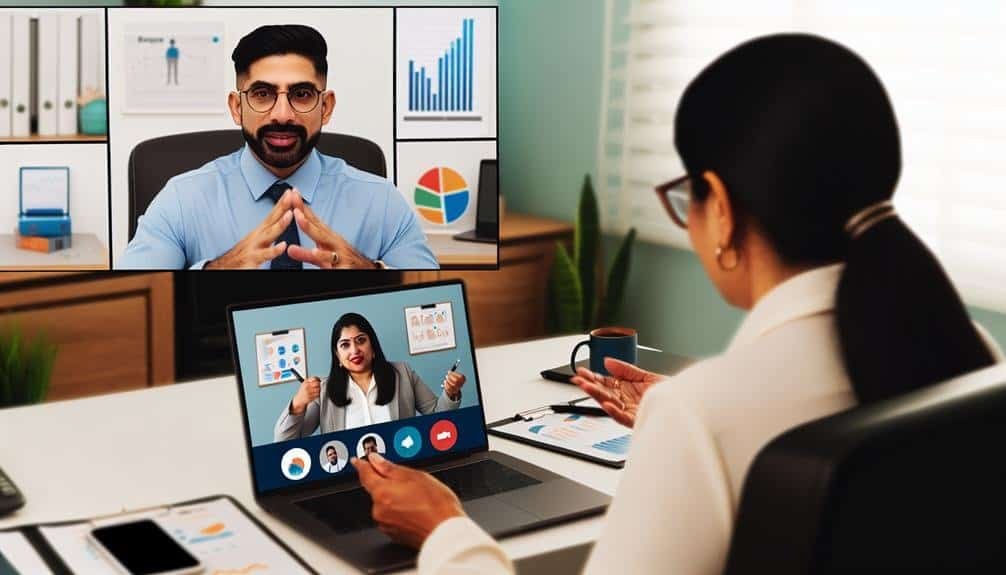Virtual Feedback and Performance Reviews: A New Approach
In today's rapidly evolving work landscape, the shift towards virtual feedback and performance reviews is becoming increasingly prevalent. The traditional methods of in-person evaluations and feedback sessions are no longer the norm, as remote work and digital communication continue to reshape the way organizations operate.
As such, the need for a new approach to feedback and performance reviews is clear. This shift presents both challenges and opportunities, and it is essential to explore the potential benefits and pitfalls of this virtual paradigm.
The virtual nature of feedback and performance reviews brings forth unique considerations that demand a strategic and thoughtful approach.
Key Takeaways
- Virtual feedback and performance reviews enhance professional development and evaluation.
- Technology can be leveraged to overcome communication limitations and facilitate real-time feedback exchange.
- Establishing clear evaluation criteria is crucial for effective virtual performance reviews.
- Real-time feedback tools and platforms, such as Slack and Zoom, can be utilized to facilitate feedback exchanges and track employee activities.
The Importance of Virtual Feedback
The significance of virtual feedback in enhancing professional development and performance evaluation cannot be overstated. In the current landscape of remote communication and virtual collaboration, the role of virtual feedback has become increasingly vital.
It plays a crucial part in providing employees with timely and constructive input, which is essential for their growth and success. Through virtual feedback, employees can receive guidance on their work, identify areas for improvement, and recognize their strengths. This form of communication also fosters a sense of connection and engagement, despite physical distance.
Moreover, virtual feedback allows for ongoing discussions and check-ins, promoting a continuous cycle of improvement and learning. It enables managers to provide regular support and recognition to their teams, which is especially important in remote work environments where face-to-face interactions are limited.
Challenges of Remote Performance Reviews
Navigating the shift to remote work has presented organizations with a myriad of challenges when it comes to conducting performance reviews. One of the major challenges is communication. Without face-to-face interactions, the nuances of non-verbal communication can be lost, leading to misunderstandings or misinterpretations during the performance review process. Additionally, technology limitations and interruptions during virtual meetings can hinder the smooth flow of feedback delivery and discussion.
Another significant challenge is maintaining employee engagement during remote performance reviews. Employees may feel disconnected from the organization and their managers, impacting their motivation and receptiveness to feedback. Without the physical presence of a manager, employees might find it difficult to establish a personal connection, which is crucial for effective performance discussions.
Furthermore, the lack of in-person interaction can make it challenging for managers to accurately gauge an employee's behavior and performance. Managers may struggle to observe non-verbal cues, such as body language and facial expressions, which are valuable in understanding an employee's reaction to feedback.
Addressing these challenges requires a strategic approach that incorporates effective communication tools and techniques to maintain employee engagement and ensure a comprehensive understanding of an employee's performance in a remote work setting.
Leveraging Technology for Feedback
Adapting to remote performance reviews has necessitated a reliance on technology to facilitate effective feedback delivery and communication with employees. Technology integration has become crucial in maintaining a robust feedback culture and efficient performance management in virtual work environments. Leveraging various digital tools and platforms enables organizations to ensure continuous and constructive feedback loops, fostering employee growth and development.
| Technology Integration | Benefits |
|---|---|
| Virtual Communication Tools | Facilitates real-time feedback exchange |
| Performance Management Software | Streamlines feedback documentation and tracking |
| Data Analytics Platforms | Provides insights for targeted feedback and improvement areas |
| Feedback Aggregation Systems | Centralizes feedback from multiple sources for holistic reviews |
| AI-enabled Feedback Solutions | Offers personalized feedback recommendations based on performance data |
Establishing Clear Evaluation Criteria
Incorporating explicit and measurable evaluation criteria is essential for fostering an objective and meaningful performance review process in virtual work environments. Establishing clear evaluation criteria helps in setting performance standards and transparent expectations for employees, aligning their efforts with organizational goals.
When defining evaluation criteria for virtual performance reviews, consider the following:
- Quantifiable Metrics: Define specific, measurable, and attainable goals that employees can work towards. This could include targets such as sales figures, project deadlines met, or customer satisfaction ratings.
- Behavioral Competencies: Outline the behavioral competencies expected from employees, such as communication skills, teamwork, adaptability, and leadership qualities. These criteria provide a holistic view of an employee's performance beyond just quantitative metrics.
- Alignment with Organizational Values: Ensure that the evaluation criteria are aligned with the organization's core values and long-term objectives. This alignment helps in reinforcing the desired organizational culture and promoting behaviors that support the company's mission.
Real-time Feedback Tools and Platforms
Real-time feedback tools and platforms have become essential for organizations. They provide instant feedback, track virtual performance, and facilitate interactive feedback sessions. These tools enable timely and targeted feedback, allowing for immediate course correction and performance improvement.
Tools for Instant Feedback
In today's dynamic work environments, the availability of advanced tools and platforms facilitates the seamless integration of real-time feedback mechanisms, enhancing the overall performance review process. When it comes to tools for instant feedback, several options cater to the needs of virtual communication and remote collaboration:
- Slack: This platform allows for instant messaging, file sharing, and channel-based communication, enabling quick and direct feedback exchanges among team members.
- Zoom: With its chat and annotation features, Zoom provides a real-time feedback environment during virtual meetings and collaborative sessions.
- 15Five: This tool enables continuous feedback loops, weekly check-ins, and one-on-one conversations, fostering a culture of ongoing development and improvement.
These tools not only streamline the feedback process but also promote a more connected and responsive work culture.
Virtual Performance Tracking
Amidst the landscape of tools for instant feedback, the focus now shifts to the realm of virtual performance tracking. Real-time feedback tools and platforms play a pivotal role in enhancing productivity and fostering continuous improvement within remote work environments.
Virtual performance management has become essential in ensuring that employees working remotely are effectively monitored and supported. Remote performance tracking tools offer real-time insights into employee activities. This allows managers to identify potential issues, provide immediate feedback, and offer support when needed.
These platforms enable the continuous monitoring of individual and team performance, facilitating ongoing improvement and goal alignment. By leveraging virtual performance tracking, organizations can maintain a high level of productivity and ensure that remote workforces remain engaged and connected.
This approach fosters a culture of accountability and transparency, driving overall performance and success in remote work settings.
Interactive Feedback Platforms
Interactive feedback platforms play a crucial role in facilitating real-time communication and performance evaluation within remote work environments. These communication platforms are essential for virtual performance management and technology-driven evaluation.
Here are three key features of interactive feedback platforms:
- Real-Time Feedback: These platforms enable immediate and ongoing feedback, allowing for timely adjustments and improvements in performance.
- Multi-Channel Communication: They provide various channels for communication, including chat, video calls, and collaborative tools, ensuring effective and seamless interaction between managers and employees.
- Data-Driven Insights: Interactive feedback platforms leverage data analytics to provide valuable insights into employee performance trends, strengths, and areas for development.
Fostering Growth and Development Virtually
During virtual performance reviews, fostering growth and development through constructive feedback and targeted goal-setting is essential for maintaining employee engagement and productivity. In a remote work environment, virtual coaching and remote mentorship play a crucial role in helping employees reach their full potential. By providing regular and specific feedback, managers can guide their teams toward improvement and skill development. Setting clear and achievable goals is equally important, as it gives employees a sense of purpose and direction. This fosters a growth mindset and motivates individuals to enhance their performance.
| Benefits of Virtual Coaching and Remote Mentorship | Impact on Employees |
|---|---|
| Flexibility in scheduling coaching sessions | Increased motivation and morale |
| Access to a wider range of mentors and coaches | Enhanced skill development and learning |
| Opportunity for personalized one-on-one guidance | Improved job satisfaction and retention |
| Encouragement of self-directed learning | Strengthened sense of belonging and support |
Creating a Culture of Continuous Feedback
Creating a culture of continuous feedback within an organization involves fostering a mindset of continuous improvement, where employees are encouraged to seek out and act on feedback regularly.
This includes implementing real-time performance evaluation processes that allow for immediate feedback to be given and received.
Moreover, it involves promoting ongoing developmental conversations between managers and their team members to ensure that feedback is not only given during formal performance reviews but is integrated into everyday interactions.
Continuous Improvement Mindset
Fostering a culture of continuous feedback within an organization is essential for promoting ongoing improvement and growth. This continuous improvement mindset is especially crucial in the context of remote engagement, where regular in-person interactions may be limited.
Here are three key strategies for creating a culture of continuous feedback:
- Encourage open communication channels: Establish transparent communication channels to allow employees to provide feedback, ask questions, and share ideas easily.
- Provide regular performance check-ins: Conduct frequent performance discussions to provide ongoing guidance, support, and constructive feedback to employees.
- Foster a learning culture: Encourage a mindset of continuous learning and development, where employees are motivated to seek feedback, learn from experiences, and continuously improve their skills and performance.
Real-Time Performance Evaluation
In cultivating a culture of continuous feedback, an integral component is the implementation of real-time performance evaluation to ensure timely and relevant insights for ongoing improvement and growth within the organization. Immediate impact and continuous assessment are crucial aspects of real-time performance evaluation, allowing organizations to address issues as they arise and capitalize on opportunities promptly. This approach fosters a proactive and agile work environment, where employees receive feedback in the moment, enabling them to make necessary adjustments and improvements swiftly. To illustrate the significance of real-time performance evaluation, consider the following comparison:
| Traditional Performance Reviews | Real-Time Performance Evaluation |
|---|---|
| Annual or bi-annual feedback sessions | Ongoing feedback and assessment |
| Delayed response to issues | Immediate impact and resolution |
| Limited opportunities for improvement | Continuous assessment and growth |
| Compliance-focused | Development-focused |
Implementing real-time performance evaluation can significantly enhance employee performance and contribute to the overall success of the organization.
Ongoing Developmental Conversations
Ongoing developmental conversations play a pivotal role in establishing a culture of continuous feedback within an organization, fostering professional growth and enhancing performance. These conversations involve regular and open dialogues between managers and employees, focusing on developmental coaching and growth opportunities.
Here's how ongoing developmental conversations contribute to creating a feedback culture:
- Continuous Improvement: By engaging in ongoing developmental conversations, employees receive consistent feedback, enabling them to continuously improve their skills and performance.
- Enhanced Engagement: Regular discussions about development and growth demonstrate to employees that their professional advancement is valued, leading to increased engagement and motivation.
- Proactive Issue Resolution: These conversations provide a platform to address challenges and concerns in real-time, fostering a proactive approach to issue resolution and preventing performance issues from escalating.
Conclusion
In conclusion, virtual feedback and performance reviews have revolutionized the way organizations evaluate and develop their employees. By leveraging technology and establishing clear evaluation criteria, companies can provide real-time feedback and foster growth and development virtually.
This new approach creates a culture of continuous feedback, allowing employees to thrive and excel in their roles. It's a game-changer in the world of performance management, ensuring that every individual has the support and guidance they need to succeed.







